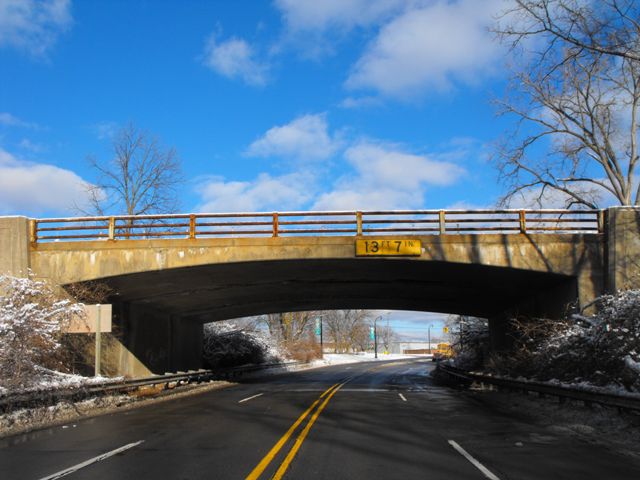We Recommend:
Bach Steel - Experts at historic truss bridge restoration.
BridgeHunter.com Phase 1 is released to the public! - Visit Now
Hines Drive Ann Arbor Road Bridge

Primary Photographer(s): Nathan Holth
Bridge Documented: December 15, 2010
Livonia: Wayne County, Michigan: United States
1948 By Builder/Contractor: J. H. Baker and Sons of Port Huron, Michigan
Not Available or Not Applicable
72.8 Feet (22.2 Meters)
72.8 Feet (22.2 Meters)
48 Feet (14.63 Meters)
1 Main Span(s)
82182101000S010

View Information About HSR Ratings
Bridge Documentation
View Archived National Bridge Inventory Report - Has Additional Details and Evaluation
Hines Drive as well as some of the other roads and crossings in the various River Rouge parkways contain a number of old bridges of interest including concrete arch bridges. Nearly all of them have lost their original railings however. Specifically, a number of old rigid-frame bridges are along Hines Drive, but this is the only one that retains its original railings. This bridge also is among the earliest of the bridges built. The Historic Bridge Inventory thus highlighted this bridge among all the other old bridges on Hines Drive and as a result the bridge was listed in the National Register of Historic Places. The only noteworthy loss of historic integrity with this bridge is the fact that both plaques on the bridge have been stolen.
Rigid frame bridges are rare in Michigan. The state highway department only built a limited number of the bridge type. The conglomeration of county-designed rigid-frame bridges along Hines Drive are thus an anomaly among Michigan's collection of old and historic bridges.
The bridge appears to be in decent condition, however spalling on the underside of the superstructure needs to be repaired before it has a chance to deteriorate further. There also is a small tree growing out of a seemingly small gap in the abutment at the northeast corner of the bridge. Cutting this tree out would be something that county maintenance workers could do and it would help ensure that the bridge is not damaged by the growth of the tree.
Because the retention of original railings on this bridge is one of the key elements that distinguish this bridge, any future rehabilitation work should ensure that the original railings are preserved and not removed and replaced. As they are today, they could stand a fresh coat of paint to protect the steel from deterioration.
Information and Findings From Michigan Historic Bridge InventoryEdward N. Hines Drive follows a pleasantly wooded
parkway along the Rouge River. Just before it reaches Plymouth, it
crosses over Ann Arbor Road (Old M-14). The railings on the rigid-frame
structure consist of three rows of horizontal metal channels on metal
box posts, with solid concrete parapets on the ends over the abutments.
Sidewalks are on each side of the roadway, which carries two lanes of
traffic in each direction and wide shoulders. Modern metal guardrail has
been added to pipe posts between the southwest sidewalk and the road; a
cable runs along the top of this rail. |
![]()
Photo Galleries and Videos: Hines Drive Ann Arbor Road Bridge
Bridge Photo-Documentation
Original / Full Size PhotosA collection of overview and detail photos. This gallery offers photos in the highest available resolution and file size in a touch-friendly popup viewer.
Alternatively, Browse Without Using Viewer
![]()
Bridge Photo-Documentation
Mobile Optimized PhotosA collection of overview and detail photos. This gallery features data-friendly, fast-loading photos in a touch-friendly popup viewer.
Alternatively, Browse Without Using Viewer
![]()
Maps and Links: Hines Drive Ann Arbor Road Bridge
Coordinates (Latitude, Longitude):
Search For Additional Bridge Listings:
Bridgehunter.com: View listed bridges within 0.5 miles (0.8 kilometers) of this bridge.
Bridgehunter.com: View listed bridges within 10 miles (16 kilometers) of this bridge.
Additional Maps:
Google Streetview (If Available)
GeoHack (Additional Links and Coordinates)
Apple Maps (Via DuckDuckGo Search)
Apple Maps (Apple devices only)
Android: Open Location In Your Map or GPS App
Flickr Gallery (Find Nearby Photos)
Wikimedia Commons (Find Nearby Photos)
Directions Via Sygic For Android
Directions Via Sygic For iOS and Android Dolphin Browser
USGS National Map (United States Only)
Historical USGS Topo Maps (United States Only)
Historic Aerials (United States Only)
CalTopo Maps (United States Only)

